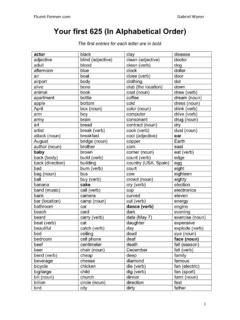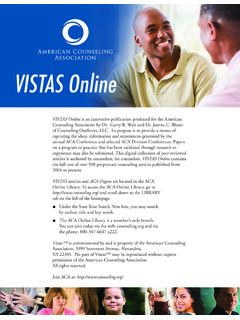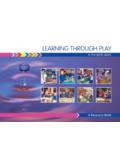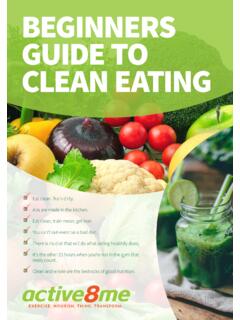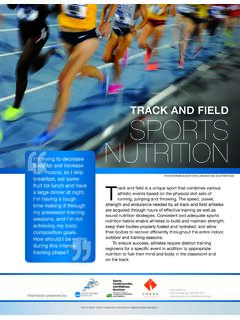Transcription of Lesson 1 – Food and Health
1 15 healthy jarjums make healthy food choicesLesson 1 food and Health Learning statements and ways of working addressed in Lesson 1 EARLY LEARNING AREAL earning StatementsHealth and Physical LearningChildren build a sense of wellbeing by making choices about their own and others Health and safety with increasing independenceActive Learning ProcessesChildren think and enquire by generating and discussing ideas and plans and problem solvingChildren think and enquire by investigating their ideas about phenomena in the natural world Year 1 Learning StatementsChildren build knowledge, understanding and skills to: Health and Physical Learningidentify healthy food choicesreflect on and identify how choices and actions influence Health and wellbeingActive Learning Processesinvestigate appropriate resources to meet design needsdesign and communicate ideas through play, drawings or concrete materialsmake products to respond to personal or group needsKEY LEARNING AREAE ssential Learnings by the end of Year 3 Health and Physical EducationHealth behaviours and choices are influenced by personal factors, people and environmentsA selection of foods from the five food groups is necessary to support growth, energy needs, physical activity and Health and wellbeingIndividual behaviour and actions.
2 Including adopting safe strategies at home, on and near roads, near water, and in relation to the sun, can promote Health and wellbeing and safety Ways of workingDuring this Lesson students will: pose questions and plan simple activities and investigations identify and collect information and evidence draw conclusions and make decisions apply personal development skills when interacting with others reflect on and identify how behaviours, skills and actions influence Health and wellbeing, movement capacities and personal development reflect on learning to identify new understandings16 healthy jarjums make healthy food choicesLearning objectivesBy the end of this Lesson students will be able to:1 List aspects that contribute to good Demonstrate the Grow, Glow, Go actions in relation to food and Identify past, current and future food choice Describe how they have grown and List different sources of food in their Reflect on where people live and how it affects the food choices available to Demonstrate taking turns and listening to others without Compare similarities and differences between people at different stages of Express feelings openly and honestly and listen to other people's Flip charts 1, 2, 3.
3 4 Paper Coloured pencils or crayons Chalk/whiteboard marker pens Home activity handouts for each student Gardening requirements depending on the activity selected (see Activity 7).Things to do before the Lesson Invite local Health worker to co-present session (see contact list in manual for more details) Ask students to bring in two photos of themselves (1 baby, 1 older) OR have photos of babies and older children taken from magazines or the Internet to use in case students don't have photos of themselves Read background information Get coloured pencils/felt pens and paper ready Photocopy front cover of My food Book , 'Grow, Glow, Go' and We need food handouts Access story book for Activity 5 (see suggested resources p 86-89) Plan food growing jarjums make healthy food choicesLesson 1 food and Health Background readingBeing healthy What does this mean?
4 For many people, being healthy means different things. For Aboriginal and Torres Strait Islander people, Health is a complex issue and is impacted on by a wide range of factors. The National Aboriginal Health Strategy Working Party produced the following definition of Health : Health does not just mean the physical wellbeing of the individual but refers to the social, emotional, spiritual and cultural well-being of the whole community. This is a whole-of-life view and includes the cyclical concept of life-death-life. 3 This Lesson needs to be approached with this definition in of Eating food that are healthy ChoicesOur bodies are just like cars - you need to put the right things in them if you want them to work properly.
5 If you put sugar in a car it would not work. It is the same for your body - you need to put the right things in to make it work properly. However, being healthy is not only about our body being healthy - it also includes feeling happy and feeling good about ourselves and and Health Grow, Glow and GoAll living things need food to stay alive, eg. animals and plants need food and water to stay alive, to grow and to be healthy . There are many ways to describe the relationship between food and Health . It is important to keep your explanations positive rather than negative, eg. NOT don t sneeze or cough on food INSTEAD suggest turn your head away from food when sneezing or coughing .Examples of positive statements about food and Health include: food : Protects your body from sickness Helps your sores to heal quickly Helps you to grow Makes your bones and teeth strong Makes your hair shiny Provides you with energy to work and play Keeps your muscles working properly.
6 3 National Aboriginal Health Strategy Working Party. 1989. National Aboriginal Health jarjums make healthy food choicesOne way of looking at how food helps our bodies is the Grow, Glow and Go concept: GROW (or protein) foods include meat, fish, chicken, seafood, kangaroo, nuts, emu, eggs, milk, cheese and yoghurt. These foods help you to grow and to repair body organs. GLOW (or protection) foods include all fruits, vegetables and berries whether they are fresh, tinned or frozen. These foods are full of vitamins and minerals which provide protection against illness. GO (or energy) foods include bread, damper, breakfast cereal, rolled oats, rice and pasta. These foods give you the energy to run, jump, play and Grow, Glow, Go concept is very useful for children and those with low literacy you are thirsty, the best drink to have is water.
7 Water keeps the body hydrated and keeps the blood flowing. Without water our body would dry out and stop drinks like soft drink and juices do have water in them but are often high in sugar. These drinks can fill children up so they won t want to eat at mealtime and they can cause tooth , Current and Future food ChoicesIt is important that students are empowered to develop a sense of control over food choices. When the children were babies and toddlers, they had virtually no control over their food choice. They ate what they were given and spat it out if they didn t like it. For many children at school, they are given more and more opportunities to make food choices. These food choices occur at the tuckshop, when food shopping with parents/guardians and when eating and preparing food in the family children do not eat food because of its nutritional value.
8 They eat food because they like the taste, they see other children eating it, because they are hungry or because it s meal time. In most instances, they eat food in a social setting with family or friends. This social interaction whilst eating helps meet the children s social interaction around mealtime plays an important cultural role for many Aboriginal and Torres Strait Islander families. Families can be quite large, so mealtimes can be a special (and noisy!) occasion. The cultural importance of food is discussed more in the background reading for Lesson 3 Aboriginal and Torres Strait Islander Foods .19 healthy jarjums make healthy food choicesWhere Does food Come From?For most children living in cities, food comes from the supermarket, although some people in cities also get food from markets and their own gardens.
9 For children living in the bush or the country, food can come from the store, a vegetable garden, the sea, the farm, the river or the bush. Where you live influences what food is available. Some people may see living in the city as an advantage as they have a wide range of food available to them all year round. Some people see living in the bush or country as an advantage as they can access bush tucker or may have their own vegetable gardens. It is important for children to recognise these differences and the advantages of living where they live with regards to food jarjums make healthy food choicesLesson 1 Plan ContentResourcesPre-evaluation of students food knowledge and activity, repeated after Lesson 4, evaluates what your students learn about healthy food choices during this program.
10 Ask students to circle foods that are good to eat every day ('everyday' foods) Copy the lunch box and foods for the lunch box templates in Section 4 (p 75-76) and give them to each student. The students construct the lunch box and choose five foods they would like to take for lunch . Record these choices so you can compare them for each student to see if any change in food preference has occurred after Lesson 4. Everyday foods pre-test handout (Section 4 p 77) lunch box Foods for the lunch boxThese may need to be cut out already for younger children( Save the food pictures to use again in Lesson 4)Activity 1 Being HealthyAsk students to suggest some things we need to be happy and healthy , eg.













